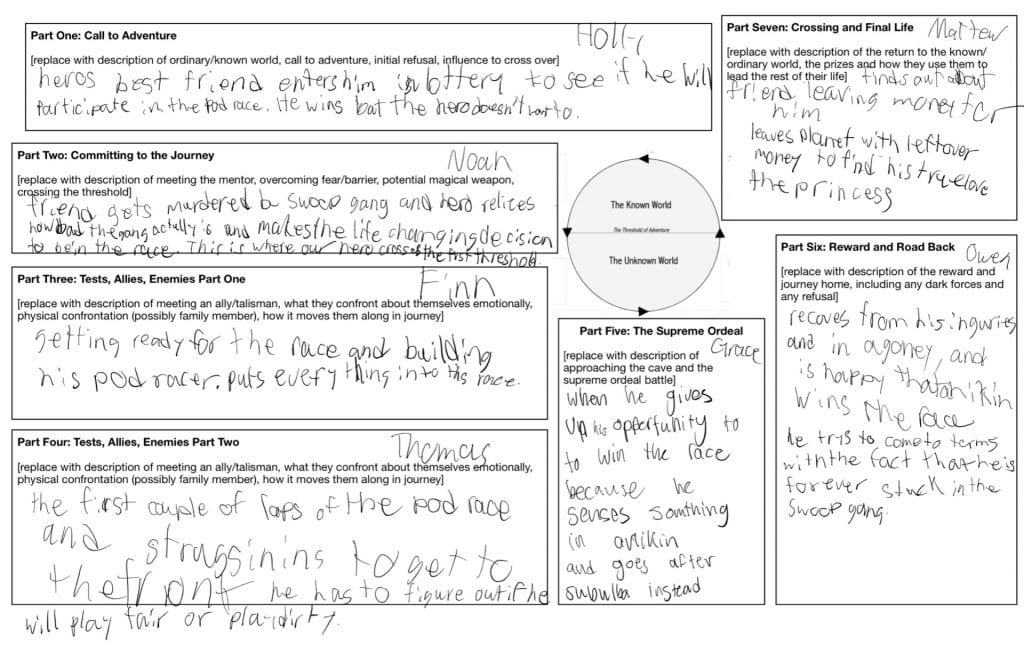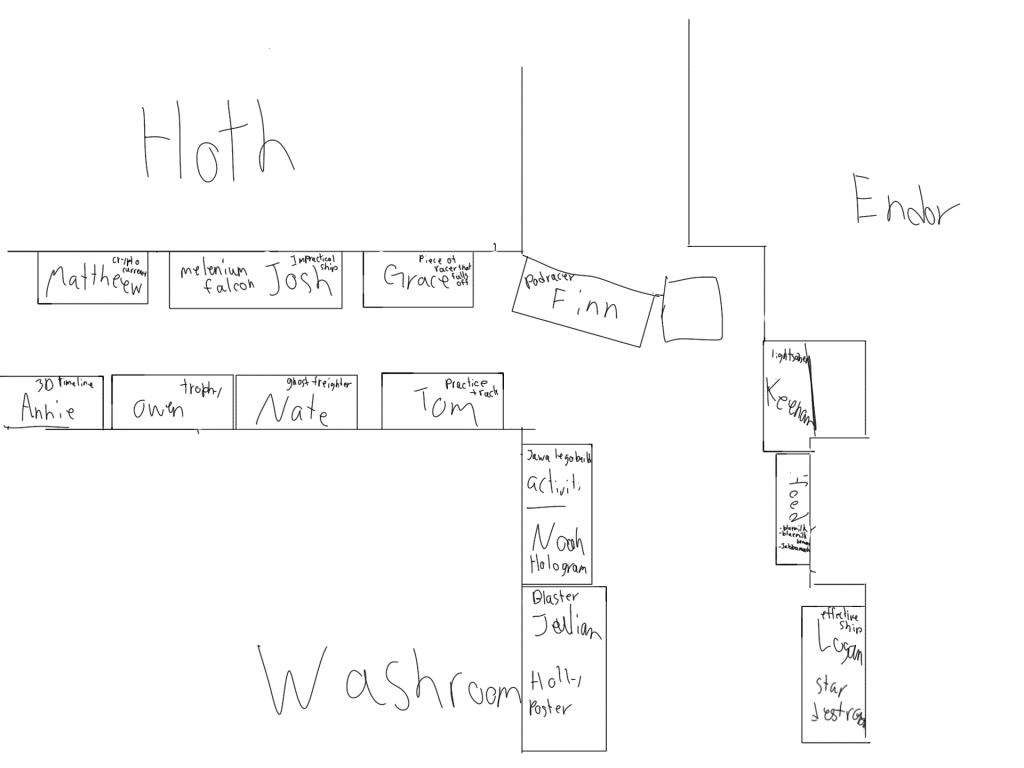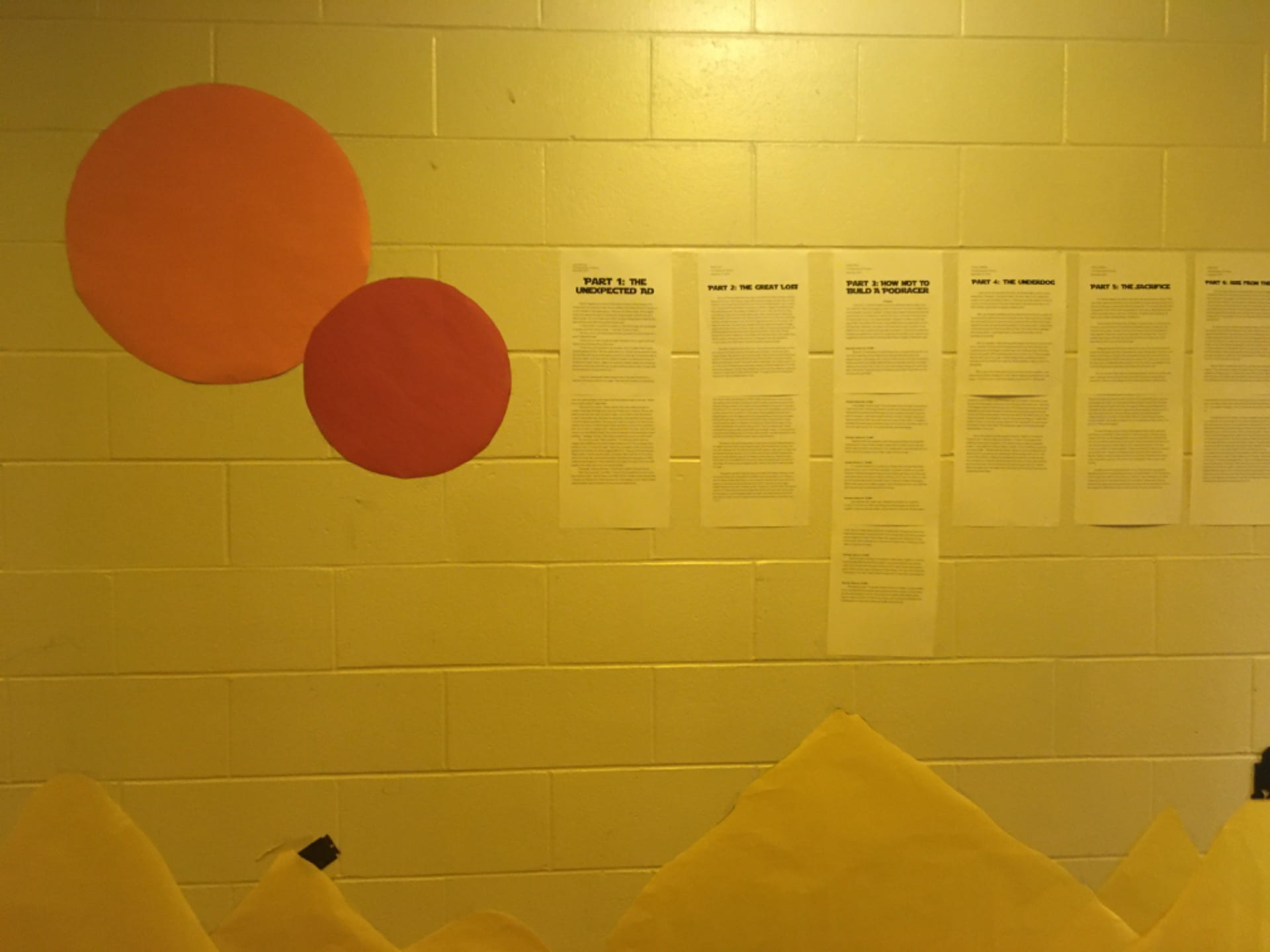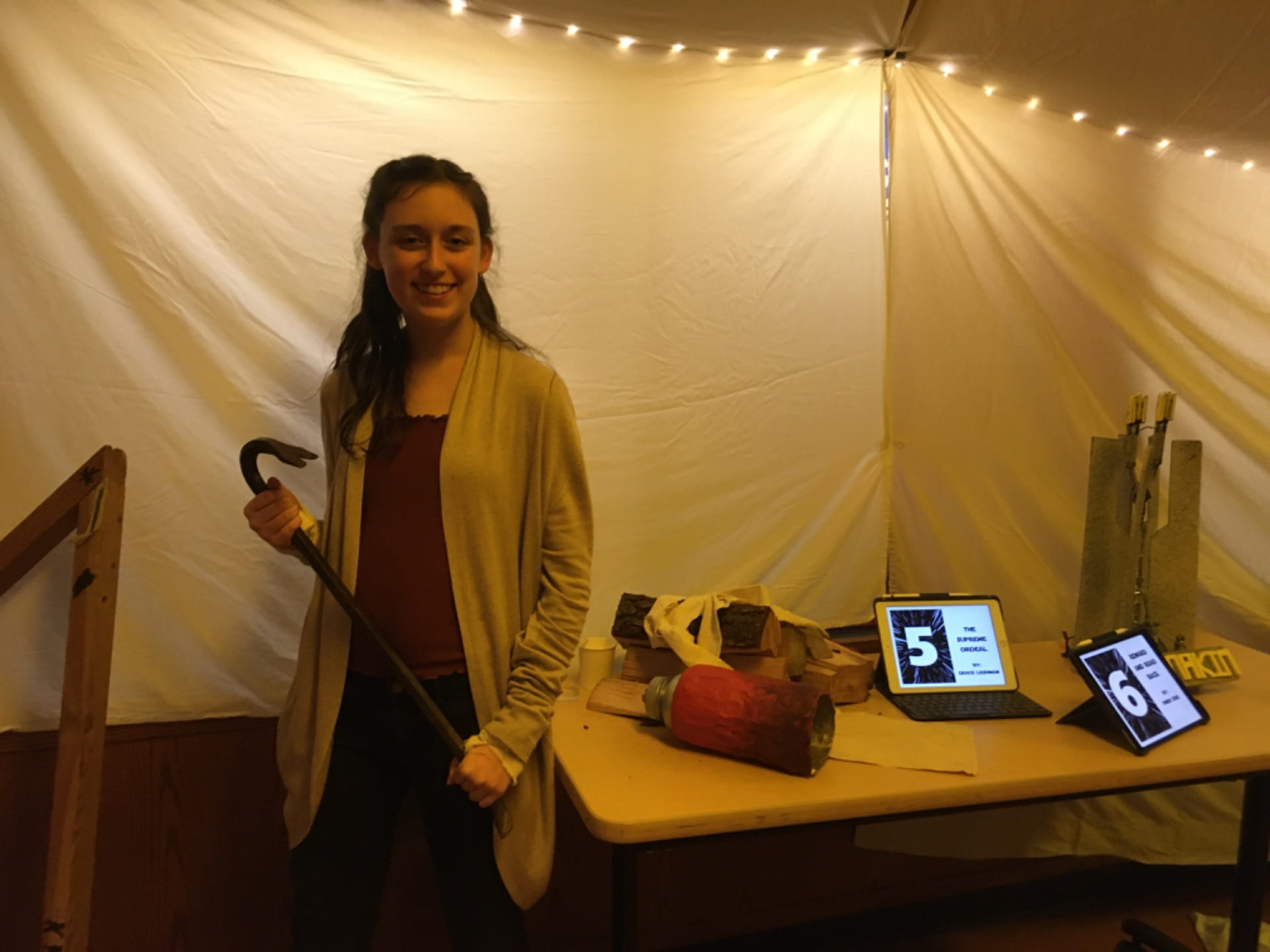Hey guys, as most of you know each year PLP does a Winter Exhibition in December to show off the amazing skills we have learned so far in the year. Each grade is given a huge project that are usually a mix of Humanities and Maker combined. This year was no different. Although both classes had their own specific project for my class they both shared the same driving question:
How might we build an interactive exhibit which explains the hero’s journey?
Since these two projects both shared the same driving question they became much more dependent on each other than the projects I completed last year. (You can see the post about that exhibition here.) Because they were both so intertwined with each other I’ll be jumping between the two projects so you get an idea of what the process was actually like. Now, without further delay, I’ll start to reflect to my work in these projects.
For the humanities part of the project we were asked to create a story about a background character in the Star Wars universe that followed The Hero’s Journey.
The Hero’s Journey is a story telling technique that many story’s follow such as: Harry Potter, Percy Jackson, and of course Star Wars. The Hero’s Journey has seven main stages.
1. The Call To Adventure: the hero lives in an ordinary world but they are usually different, not part of this world. They are called to leave this world and help fight some sort of evil but initially refuse. Until something happens in this ordinary world that makes the hero want to go on this adventure.
2.Committing To The Journey: the hero usually meets an old mentor who will most likely die later in the story. This mentor helps them over come some sort of fear or barrier and the hero usually get a magical weapon of tool to help them on their adventure. The hero also ends up crossing a threshold of which there is no return to the life they had before. They are now committed to this journey.
3+4. Tests, Allies, and Enemies: armed with their new found power the hero faces many trials that helps them become more powerful. This is usually the part of the book where the hero will continue to run into trouble and have to figure out ways to get out of it. They will also usually gain allies and secondary characters during this part of the book as well as make enemies and learn more about the main antagonist.
5. The Supreme Ordeal: this is when the hero confronts the main antagonist and usually there’s a huge fight between good and evil. This is the climax of the story.
6. Reward and Road Back: the hero is rewarded for defeating the evil and now has to journey back to the ordinary world. Sometimes there are some dark forces the hero has to fight but they are able to overcome them.
7. Crossing and Final Life: the hero returns to the ordinary world changed forever. And because of their experiences they can never go back to the way they lived before.
Once we had enough understanding of these ideas it was time for milestone 3. For this milestone we were supposed to get together with our groups and use the two competencies Creating and Extending Shared Understanding, and Literacy Identification and Analysis, to come up with our story based in the hero’s journey. By now we knew that our group would be Tatooine and decided to make our story about one of the podracer in Star Wars: The Phantom Menace. We ended up deciding on making our story about Teemto Pagalies because he seemed to have the least amount of information on him and of the info there was about him he seemed like an interesting character. We came up with the idea that he could end up helping Anakin win the race and sacrificing his chance at winning. However, we didn’t use the first competency that well which resulted in a lack of communication of what was actually going to happen in the journey. If I were to do this again I would get everyone to tell me what exactly happens in their story and how it connects to the hero’s journey to make sure everyone is on the right page.
Once we understood what we were doing for our story it was time to begin our project for Maker. We were tasked with creating an artifact from our story that helps show the main idea or part of our piece of the story. To do this we followed something called a LAUNCH cycle which has five phases that help you come up with a solution to a problem, in this case that problem was what can I make that shows a significant part of my story? That brings us to the first phase of the LAUNCH cycle, L: Look, Listen, and Learn. During this phase I found that since we had already figured out what was happening in our stories I already had a set idea of what I wanted make. I think this stopped me from being more open to new ideas or ways of building off of an original idea and I would like to avoid this in the future by keeping a growth mindset and trying not to get ahead of myself. I also ran into this problem in the second phase of the LAUNCH cycle A: Ask Tons of Question. Since I knew what I wanted to do my need to know questions (NTK) weren’t very well thought out and I believe that my project was a little less imaginative because of it.
Since these projects were for the Winter Exhibition we eventually had to start thinking and planning what we would be doing with the space given to us. My team got the hallway which, as you could imagine, was a nightmare to try and plan how the flow of the room would work. What made it even harder was that two of the people in my group, Thomas and Finn, had really big projects they had decided to make.

This made it a lot harder to come up with a plan since they both had to be beside or close to each other for the flow of the room. We also had some problems where we all had individual ideas on what we could do, which were all great, but we couldn’t figure out how to weave them all together into one idea. Luckily, during the midst of our struggles the grade 12’s were sent in to get us all on track, and it had worked. They had basically took over the layout part of the process and told us how it should all work which was exactly what we needed at that point. They also listened to our ideas and helped us improve them and sew them all together into one plan for the night of the exhibition. Personally, I think that I could have been a little more assertive in our discussion of what was happening because although the grade 12’s were very good at helping us on how everything should work together. They misjudged how people would move through the rooms and even though I had a gut feeling that that wouldn’t work in the end I didn’t speak up. I feel that in this instance I wasn’t very good at using the Creating and Extending Shared Understanding competency. I didn’t speak up and exchange my viewpoint that this may not work so we could create a solution to that problem or come up with a better way to create a flow to the room.
While we were creating our ideas of what to create and how to showcase everything in our exhibit we were also writing our short stories for each part of the hero’s journey. I ended up writing the Supreme Ordeal which we decided that Teemto would knock Anakin’s rival aside so Anakin could get an advantage. However, the rival would hit back crashing Teemto and leaving him for dead. (Here are the links to my groups blog posts for the rest of the story: Holly: Part 1, Noah: Part 2, Finn: Part 3, Thomas: Part 4, Owen: Part 6, Matthew: Part 7)I feel that this was the part of this project that I did the best in, there are a few reasons that I think this. First of all, I’ve already had some experience with the Writing Process competency when writing my own short stories. Because of this previous experience I was able to plan out what I was going to write beforehand in my head which I believe helped me stop myself from going off topic and having a way longer story than what was needed. I also was able to use this competency to look at my story and know that it needs some work and revision, and once I had revised it we got feedback and I was able to understand that I needed to rewrite the whole thing to create an even better story. Another reason is, while I was writing and revising my story I was able to use the Literary Identification and Analysis competency to add to my story and make it more interesting to read since I was using the different literary devices that we had learned in class.
The last couple of milestones had been going on all at the same time and parts U and N of the LAUNCH cycle are no different. After we had finished the A phase of the LAUNCH cycle it was time to move on to U: Understand the Problem or Process. In this phase we had to research our idea for what we were going to do so we can understand what our process should be and fix any problem with our initial idea. I feel like I did very well at looking at what I wanted to make and using the resources provided to help me understand that I may not be able to complete some of my ideas which set me up for the next phase in the LAUNCH cycle, N: Navigate Ideas. This phase directly ties in with U since I can use the understanding of what won’t work from the U phase to come up with even better ideas. This phase helped me change my idea so I would be creating a smaller piece of Teemto’s ship because of the short amount of time we had to create this. I also changed the materials I would be using from metal and wood to paper mache and a water bottle top because they were a lot easier to work with and didn’t cost as much. I believe that both of those ideas are good examples of using the navigate ideas competency because I came up with different solutions to the problems I was presented with and was able to combine them to create an even better idea.
Finally it was time to actually start building our creation for our story in the C phase of the LAUNCH cycle: Create. This phase was pretty straight forward, we had to actually create a first draft/prototype of our creation. I think that I did really well on this milestone because I had planned everything out so well in the N phase so I could get my materials from the store without second guessing myself and start building right away. However I did run into some problems while making my project and I was able to use the Computational Thinker competency to fix them. An example of this is when I was putting the paper mache on the bottle to shape it. I had been putting them all in the same direction for about three layers but then I started to worry that since they were all put on the same way they may not hold as well so I thought about how I could solve this problem and decided that I would place the next layer vertically instead of horizontally. This may not sound very impressive but it still shows how I was able to identify a problem and fix it in a smart and easy way. After we had our initial prototype it was time for the H phase: Highlight and Fix. This phase is pretty straight forward where you take feedback and improve your design. My best example of revision in this phase is when my paint was way too bright and didn’t look like it was supposed to, I started to test different ratios of the red that I had gotten to a silver paint and after many different test I finally found the perfect mix between the two colours.
After all of this, it was now time for the actual presentation. This was when everything we had done over the last couple of months had all come together to answer the driving question. We already had a plan for where everything would go all we had to do was set it up. Wouldn’t be that hard right? Wrong, our room had almost become a total disaster because of many different events happening one after the other. First of all, since we were in the hallway we couldn’t even start to set up until 3:10 which gave us about an hour and 20 minutes to set up where the other groups had closer to two days. We were able to create a solution for that though, we just made all decorations beforehand so they can be easily put up on the day. So that wasn’t the problem we ran into, the problems came with the sheets we wanted. To put up to create a market feel to the room. It had seemed to work when we started putting them up but after a bit it was clear that the people putting them up didn’t really know where to put them. The sad thing is that if I had spoken up more than I already had I probably could have gotten them to put them up in other places and maybe even help with them. Another problem we ran into was when the grade 12’s were tasked with putting the footprints on the ground I had failed to tell them that they should be somewhat laminated by the tap when put down. So when we had realized their mistake it was too late and they were ripped up in seconds.
However, after all of these hardships we were still able to pull off a successful Winter Exhibition and answer the driving question. What is the answer you may ask? Well, all you have to do is look at our room and you have the answer right there. The way you build an Interactive exhibit that tells the hero’s journey is to create an immersive experience that comes from the story you are trying to tell with the pieces of the hero’s journey scattered across the room in a sensical way. This way people can wander around and feel like they are part of the story or watching the story happen around them.













